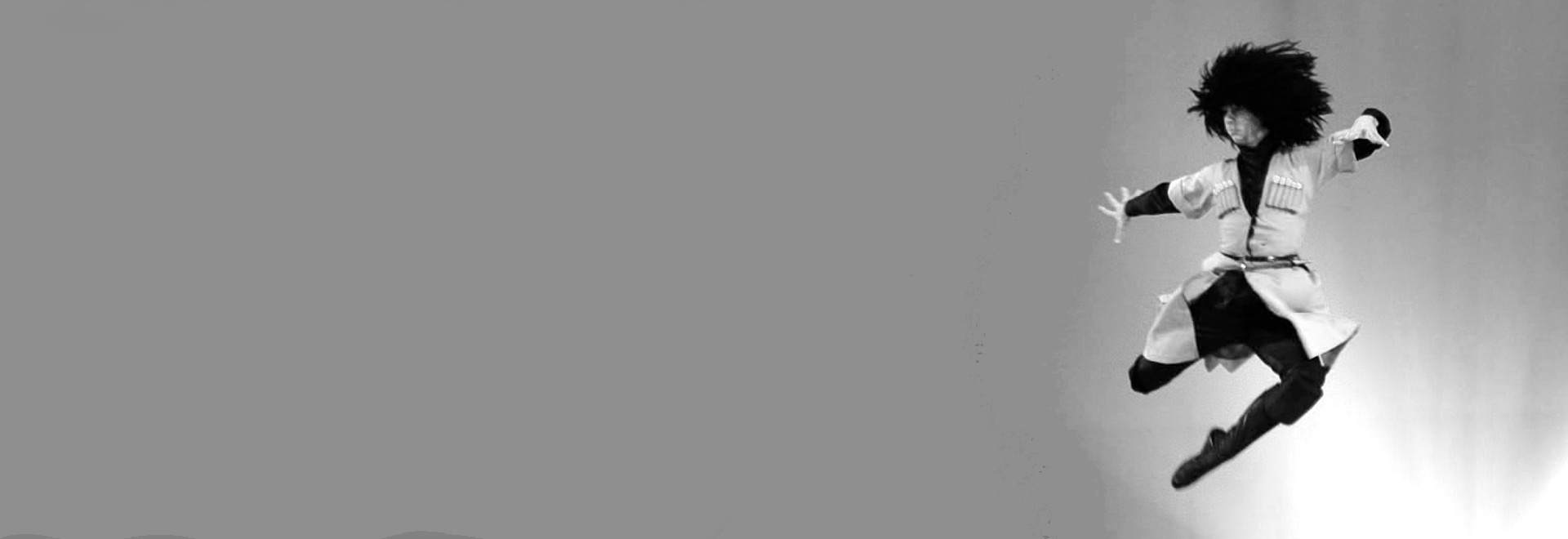Gianluca Brugnoli
Connecting the Dots of User Experience
Abstract
This paper discusses the analysis and design of user experience within networks made of distributed services and applications, where a user freely activates system components through an activity-driven process. A case study is used to outline the main characteristics of this scenario and to introduce a tool for user experience modeling and design. Based on the application of this model, I discuss how the design process might be re-imagined.
Introduction
Looking over the latest evolutions of the digital experience, we can observe the growing importance of pervasive and multichannel interactive systems. The user experience takes shape on many interconnected devices and through various interfaces and networks used in many different context and situations. To achieve their goals through the interaction flows, users tend to combine an increasing number of different applications and tools within wide and fuzzy ecosystems, where technical factors blend in with behaviour and intention. The user experience itself is the result of a non-linear and occasional combination of various systems’ fragments and components, which are activated and connected by users from case to case, following their goals and intentions in specific times, situations and contexts.
This scenario opens new challenges and opportunities for interaction designers and for companies searching for innovation. Some of the key concepts, tenets and tools of user experience analysis and design might have to be revised.
The first shift concerns the role of the user: they are always in the centre but in a different way. In the system approach, the user is the active protagonist of the experience flow, who actually selects and connects the dots of the interaction system making the experience alive. Nevertheless, for designers and analysts, user behaviour is not always a predictable and logical a priori. On the other hand, the user action affects device’s scope and features: applications and processes should be flexible enough to change role and adapt to different action flows. Primary and secondary features switch continuously following user interaction, even without a predefined or optimal action plan. In this scenario the context is not only the stage for the interaction scene. it is part of the interaction itself (Pederson 2006).
Finally, the concept of interaction should be revised. Following the activity-centred approach, the focus is no longer on the optimization of a specific task, but on the set of the multiple actions available for the user to achieve an objective in a specific situation (Gay & Hembrooke 2004).
Deconstructing the Machine
Traditionally interaction design is centred on the relation of a human with a machine or a service, where (usually) goals and sphere of action are well defined (Harrison et al 2007).
This paper begins by asking what happens if the “machine” is broken down into a network made of services and distributed applications? What happens if interaction is no longer based on functional and clear goals, but becomes an open and borderless experience where the main goal is living the experience itself?
Content is Splitting Off from Media
Today data, content, features and services tends to be increasingly open, mashable and accessible from many different contexts, with many different devices and networks. Looking towards the future, this freedom is supposed to increase further. The ubiquitous computing scenario, outlined by Mark Weiser in 1991, is becoming reality: one user, many computers. The experience will flow seamlessly through various systems made by many different distributed information-processing devices (Weiser 1991).
One of the main consequences of this vision is the centrality of data in shaping the user experience, as though to diminish the importance of the electronic devices and technical structure used to create, transfer and use this same content. A framework that worked for decades seem fading out. On one side, we can see how media and devices are getting more and more generic and unspecialized. Mobile phones, digital cameras, music and video players, portable video game console, are merging together shaping new generations of pocket hi-tech gadgets always connected to the web. On the other side content and data tends to survive the tools and the storage support used to create and enjoy them. When a device is replaced, digital information is promptly transferred and synchronized on the new gadget, ready to accommodate new content.
This is a banal but interesting paradox: data and content are more and more important and valuable than hardware, and must last much longer. That digital and volatile information for the user are meaningful. In the “cloud”, content is the king of the user experience, while any hardware device can be an interface to access remote services, data and information stored elsewhere.
A good demonstration of this reality is a video created for the launch of Android, Google’s mobile platform. In the video, a person is using a mobile phone to check email, while at a certain point he throws away the phone, and it falls in the water. No problem: he gets a new mobile phone, enters his credentials, and resume the email conversation without losing data or breaking the experience. With this platform, services, a user’s information and content live in a separate space from the hardware, which is a temporary accessory easily replaceable.
This separation between the platform and the devices used to access data has already brought some interesting social consequences in media usage. According to the 2006 annual CENSIS[1] report about communication in Italy, for young and teenage users, well-versed in the use of contemporary technology, data and content are already perceived separate from media and devices. The “music experience”, for example, by these users is described as an indefinite mosaic made up of many different things: from traditional broadcasting radio channels to web streaming radio channels and podcasting, from mp3 downloading to audio track management on portable devices. Music lovers keep alive their experience flow hopping and switching indifferently from one channel to another, from one device to another, from place to place, case by case. For most of these users, the traditional distinction between media has no sense anymore. Music, video and news are simply streams they freely catch where possible with any media and device at their disposal.
Similar situations can be detected in any digital experience where the platform is becoming more important than media and physical devices. A conversation between friends, for example, by now has become a continuous digital flow which run seamlessly through many different services, such as email, instant messages, SMS messages, Facebook comments, Twitter tweets, RSS feeds on a blog page and whatever else, without caring about the channel and the tools used to communicate. From the user perspective, the conversation is the experience; an experience based on an open ecosystem of connected products, services and applications (Merholz 2007).
Another good example of a digital ecosystem comes from digital photography (an example I’ll explore in depth later). In recent years the photography experience has expanded, with new features such as digital editing, digital album management and online publishing and sharing being offered to photographers. These new features have enriched the general photo system as well as changed the photo experience, bringing in new meanings and motivation for the user to take and share pictures. Also, strongly structured systems such as the video and television experience are not immune to such transformations, and even the old dear television box is going to be the renewed multimedia focal point of the house to enjoy many different type of content and information, from many different sources. This scenario includes both consumer, business and professional applications as well.
From the Machine to the System
Beyond any technological and business implications, these examples have a common point: that the user experience is always based on a system of connected and distributed tools, applications and channels.
From the technical point of view, this system is still fragmented and incomplete, made of many unstable connections between its parts. But from the user perspective, following their intentions and practical uses, is it supposed to be as consistent and homogeneous as possible. The user action should flow without hindrances and the result should be achieved without caring about the complexity of the underlying technical system. Interaction itself exists beyond the enabling of technology and tools. Aspects like the physical locations or the channels used to access a specific content or service are losing their importance in determining outcomes, and it is likely they will be even less important in the future. The user will be able to keep the focus on their own activities and goals, what they are doing and why, without thinking about how information and data are transferred within the system, where they are stored, how formats are converted, how to create connections and so on.
One of the clearest examples of this kind of experience is the combination of iPod, iTunes and iTunes Music Store. Consisting of a device, a desktop application and an online application, all are inseparable parts of the same user experience. The user is able to easily jump from playing music, to manage playlists or to purchase music within the same environment and action model without worrying about the data and the technology (Merholz 2007).
In user experience design the “machine” is going to be replaced by interaction systems made up of multiple touchpoints. This is a new challenge for designers. An interaction system is a both a technical and a social infrastructure as well, made by multiple and crossed interfaces, services, applications and contexts, which are the connective tissue of the user experience. It is an open, adaptive and pervasive platform in which the user freely chooses, activates and connects the parts, the tools and the components useful or available in that specific situation to achieve a result. Within this platform there are no predefined and optimized task sequences, but many non-linear action flows. The experience can start with a device in a specific context and come to an end on a different device in a different context, responding occasionally and pragmatically to user intentions and situations. Sometimes, not even all available applications in the system are immediately visible. They emerge through use, while interaction occurs ignoring infrastructure with a strong focus on the connections (Pederson 2006).
From the design point of view, understanding this system and capturing its complexity is not an easy task. The first goal is to determine its structure, map the boundaries, and identify the components and how they are connected in order to make the experience possible. The second step is understanding how users browse within this system during their activities, by determining their entry points, touch points, the connections they make, flows and goals. In the analysis and in the design process more often there is the need to see these faces together: the system organization and the user behaviour. In the next section will be proposed a model to analyze and design interaction systems.
Mapping the System: the Digital Photography Example
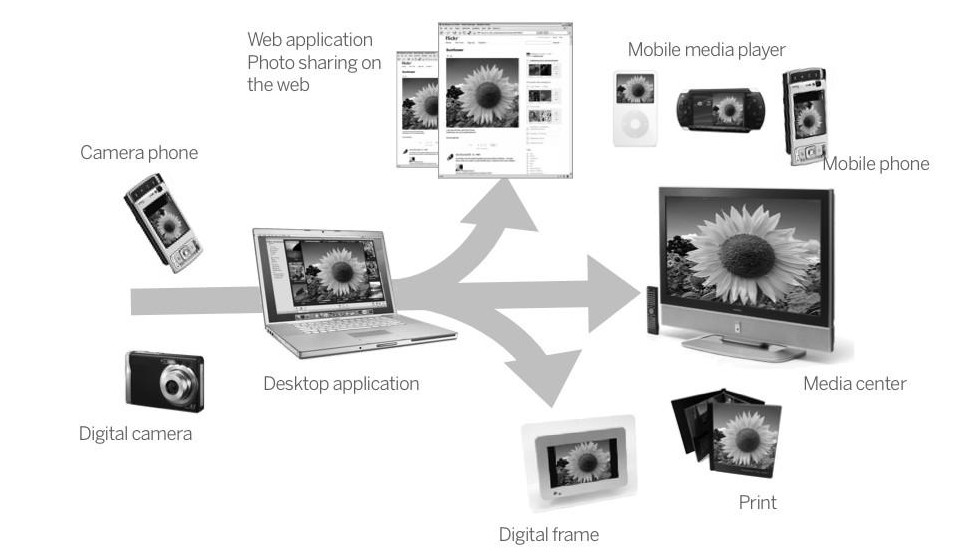
Figure 1
One of the key steps in understanding an ecosystem is to map and identify its various components. Let’s use digital photography as an example in order to show how that system can be analyzed and visualized. The digital photography ecosystem combines a traditional image capturing device with new digital applications and services, where a prominent role is now played by online publishing and sharing applications.
The bigger the ecosystem becomes following use, the more the various parts must be able to connect, communicate and exchange contents each other, frequently transcending barriers between brands, companies and business. A practical example is given by the new Apple iPhoto 200, where the software has included a Flickr and Facebook upload and data exchange feature.
On the system map, the various parts can be assigned to the different user experience stages: image capture and production, photo management and editing, digital and physical publishing on different media, and digital sharing. Now we have a high level vision of the connections between the system parts and the main user activities.

Figure 2
Once the system and its components are defined, it becomes possible to outline the scenarios in which the user puts together available parts to achieve their goals. In the following example, within the two scenarios (a) and (b), the same parts and touchpoints are combined in different configurations, shaping the user experience.
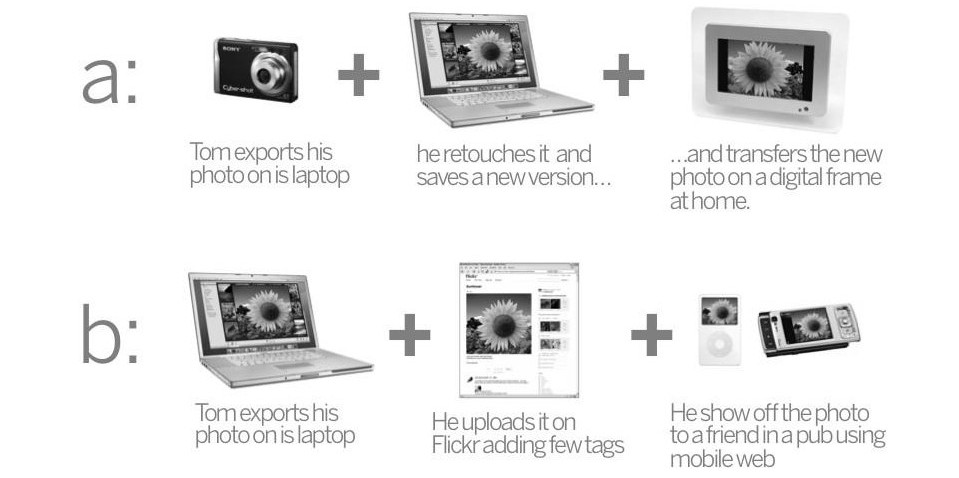
Figure 3
The following table aims to represent the photography user experience in a more analytical way than before. The main stages of the photography customer’s journey determine the horizontal dimension: capture, manage, publish and share. Each stage corresponds with the user’s intentions and key activities. The vertical dimension lists some of the key touchpoints of the system. A touchpoint is any physical or digital element of the system with which the user comes into contact during the experience. It can be a hardware device, a software application, a web service and even a physical space or tool. The dots in the intersections represent the potential user actions, the active touchpoints at each step of the experience. Accordingly, the same touchpoint can play a different role or can be exploited differently. This matrix can be seen as an architecture of the many possible user interactions within this system.
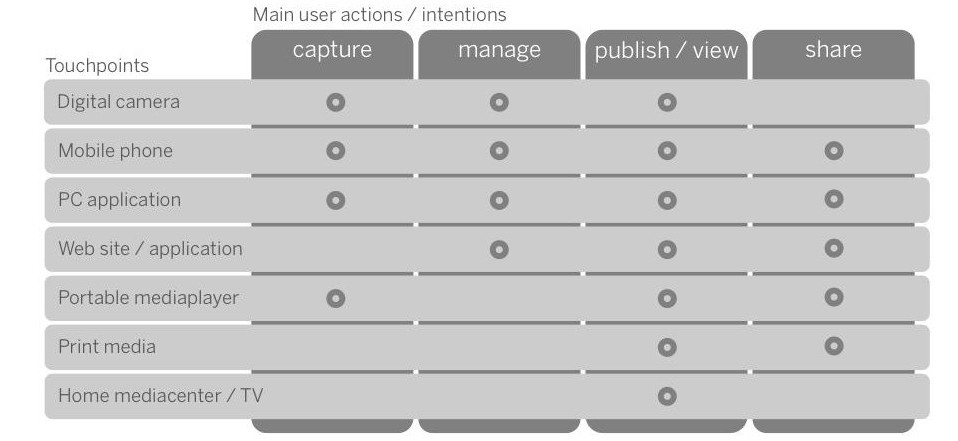
Figure 4
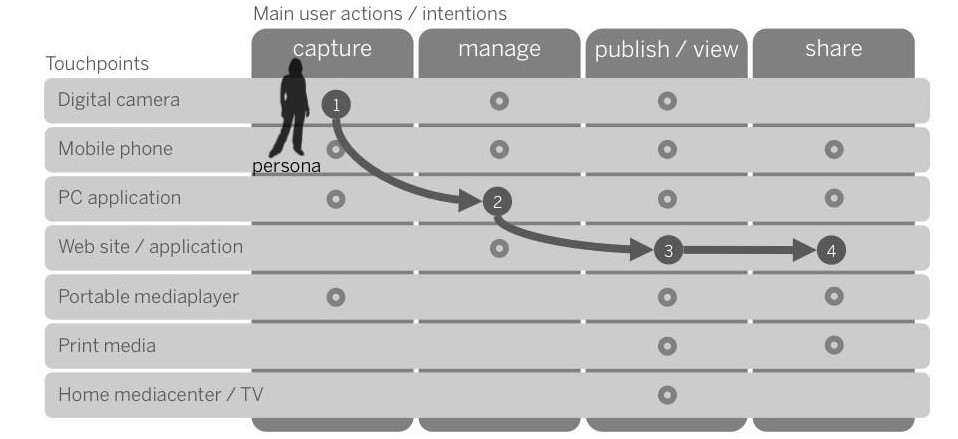
Figure 5
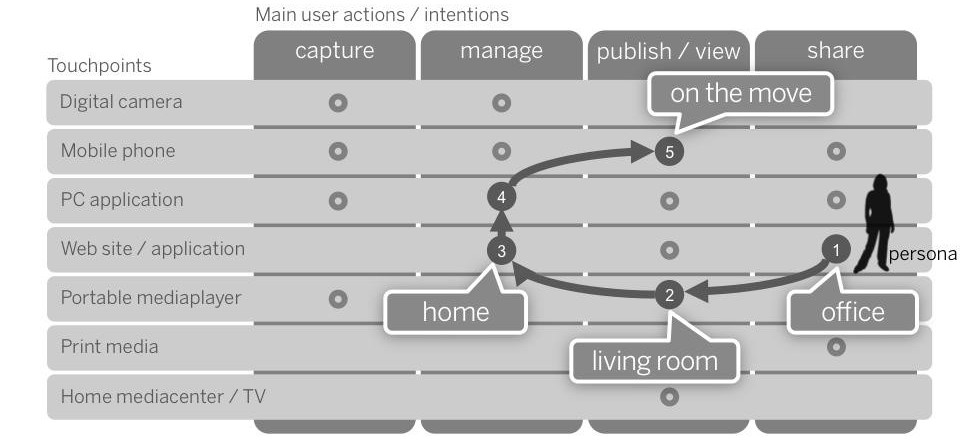
Figure 6
Connecting the dots of the matrix, it becomes possible to outline the different configurations of the user experience for each persona in the various scenarios. The sequence is based on different entry points, user goals, and data and action flows.
In this case this representation is a mere simulation, made only for exemplification purposes, therefore data and use case are not real or accurate, and can be much more sophisticated applying different zoom and detail levels. Nevertheless, for user experience designers the potentials of the model are tangible. It could be used to analyze and evaluate an existing system, as well to support a concept design phase. It makes possible to highlight design opportunities and verify business and user requirements. Mapping the boundary, the touchpoints and the components already included in the system this matrix helps to reveal the connections between the existing parts exploited with user interaction. Moreover it can be used in a project to outline the potential connections and the requirements for new components and parts (for example a new product or a new application) that would be included later.
The System is the Experience
These examples tell a story about a new dimension of product and services. In the user interaction, machines are small, many and mobile touchpoints; they are always connected, continuously exchanging data and information in the background, without user intervention. Moreover, they can share features and services, enabling the user to utilize a digital service, enjoy content and accomplish a task from any location, while employing different devices and applications.
Such systems have some interesting characteristics. The most important is the lack of a rigid structure and of a predefined hierarchy between the parts. They are open platforms for user experience, a network of opportunities, exploited practically, and occasionally, case by case. Many entry points are possible in these platforms. The user can start the interaction on a touchpoint or another following context, situation, or based on other needs or goals. There is no single or best form of user interaction. A task flow does not always follow one single optimal process, but is the combination of various partial and occasional actions accomplished by the user, with different tools, in distinct contexts.
The challenge that logically follows is to design connections. In the system scenario, design should be mainly focused on finding the right connections within the network and its parts, rather than in creating closed and self-sufficient systems, tools and services.
Connecting the Dots: Design Considerations
Helping to reveal the structure and the many invisible connections within an interactive system, the proposed model is not only an effective tool to analyze and design the user experience, but also can help us think about the user experience in a different way. Accordingly, it might bring some interesting shifts in the design process.
Approaching the project with the system view, a key design challenge is the architecture of the system and the configuration of the parts. For a positive and fulfilling user experience, the whole is more important than the parts. In consequence, the “intelligence” of the platform is more important than the “intelligence” of the single device, which could be replaced or completed by other parts, applications and other services available within the network. Before focusing on the capabilities and on the features of a single device, the design process should define the organization and the configuration of the system, identifying the possible relationships and connections between the parts that can be activated by user actions in different scenarios.
In this scenario, results are seldom delivered by a single device. Most frequently, they are the endpoint of a fragmented and random interaction flow, which goes through many devices and different user situations. Device usage is not always predefined, and follows its role within the system, which changes continuously in an opportunistic and situated way according to different user contexts and situations. Tasks and processes depend on the connections and on the parts combined by a user within the system. Primary and secondary features switch continuously following user interaction, also in an occasional and opportunistic way.
The user is always in the centre. Nevertheless in this model, users are the protagonists that freely and actively connect the dots, selecting and putting together different pieces of the system. Doing this, sometimes they create new or unexpected connections between the parts, even beyond designers’ intentions. This partial unpredictability of users behaviour within an open interaction system shouldn’t be seen as a problem to solve. It could be a design and a innovation opportunity, and one of the most interesting upcoming challenge for designers and companies.
References
- CENSIS (2006). Quinto rapporto sulla comunicazione in Italia. Cinque anni di evoluzione e rivoluzione nell’uso dei media. Franco Angeli.
- Gay, G. and Hembrooke, H. (2004), Activity-Centered Design. An Ecological Approach to Designing Smart Tools and Usable Systems. The MIT Press.
- Harrison, S., Tatar, D., and Sengers, P. (2007), The Three Paradigms of HCI. Journal of HCI. Taylor and Francis.
- Merholz P. (2007). Experience IS the Product... and the only thing users care about. Core 77 / Business week. http://www.core77.com/reactor/06.07_merholz.asp.
- Pederson T. (2006). Egocentric Interaction. In Jacob, R. J. K. (ed) CHI 2006 Workshop Proceedings: What is the Next Generation of Human-Computer Interaction? Pp. 77-80.
- Weiser, M. (1991). The Computer for the 21st Century. Scientific American, 265(3), pp. 66-75.
Footnotes
[1] CENSIS is the most important social research and studies public foundation in Italy
